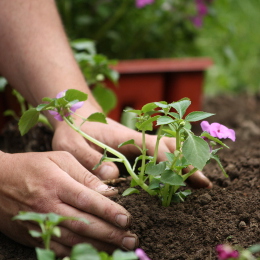Plant impatiens as bedding plants, border plants, or in containers, these gorgeous flowering plants can brighten any area. Read the Buzzle article to find instructions on how to take care of them properly.

Also known as jewelweed, balsam, and touch-me-not, impatiens are a gorgeous flowering plant that are most commonly found in the tropics and Northern hemisphere. There are many varieties found in these annual blooms like New Guinea impatiens and double impatiens. One of the most wonderful things about this plant is that you can find many different colors of flowers like red, white, blue, pink, and purple. Ranging from about 6 inches to 2 feet tall, the plants are truly a sight for sore eyes. They can be planted in shaded areas as they require filtered or partial lighting.
Since the flowers bloom from spring to fall, the seeds should be planted way before spring arrives. Whether you have planted these beautiful plants in the flower garden, or are planning on starting with a container for the balcony, the following information will provide you invaluable information.
Sunlight Requirements
These are delicate plants, and will prefer a shaded area instead; which means, they don't require direct sunlight to survive. Give them either a shaded area, or filtered light so that the flowers can stay fresh rather than become droopy. But just in case, even after planting the plants in a shaded area, there happens to be a time in the day when the sunlight does reach that location, even though after being wilted in the sunlight, once the sun is gone, they will return to their perky appearance.
Soil and Water Requirements
Keep the soil moist when needed, but make sure not to over water it; we don't want the soil to turn squashy. If the soil condition is ideal, as it contains organic materials, then you may not even have to water the plants for sometime. But here, you need to keep a check on when it rains or not. If it doesn't rain for a week or maybe even two, then you might have to water the plants to keep it from wilting. Also, the amount of mulch added to the soil plays an important role into how often you need to water them. For proper planted or potted impatiens, you need to water them every day whenever it's sunny.
Their preference on soil is mostly neutral to alkaline soil. So make sure the pH level of the soil is between 6.0―6.5. Now, a good way to know if the plants require water is by looking at their leaves or even the stem. They quickly begin to wilt when proper watering is not done. So whenever you spot this change, immediately water the plants as they will recover very swiftly. Now, if you are worried about over watering, you can acquire the drip irrigation system that will help keep the moisture level in control.
Pruning Requirements
It is known that these plants don't just grow in height, but also in width. So if you suddenly happen to find their stems growing longer around the garden area, you will know it's time to prune them. What you can do is punch 3―4 inches of the stems' tips using your fingers. Or for better results, you can clip the stems to hold the blooming process on a temporary basis. Also, when you prune the stems, the shape of the plant in general will be more appealing and the new flowers will grow more quickly.
Fertilizer and Mulch Requirements
To tell you the truth, for ideal care for the plants, you don't really need to add rich fertilizers in the soil. As we mentioned earlier, the addition of organic materials will be more than enough. Now if you have poor soil, for any reasons, you can add a spoon of slow release granular fertilizer to the soil. But do make sure to take it easy with the fertilizer as impatiens are very delicate. As for mulching requirements, add a layer to the soil as it will prevent any moisture loss. Overtime, this mulch will decompose and will in turn provide the necessary organic materials needed for the soil to flourish.
Apart from these necessary instructions, you also need to watch out for pests, insects, and diseases attacking the plants. There are some insects such as spider mites, mealy bugs, and aphids that will latch on to the plants. In such cases, you need to make sure that the mulch used in the soil is clean and dry at all times. And if you follow the guidelines mentioned in the article, you won't find any issues with either the plants getting wilted, or being infected by any diseases.






 Also known as jewelweed, balsam, and touch-me-not, impatiens are a gorgeous flowering plant that are most commonly found in the tropics and Northern hemisphere. There are many varieties found in these annual blooms like New Guinea impatiens and double impatiens. One of the most wonderful things about this plant is that you can find many different colors of flowers like red, white, blue, pink, and purple. Ranging from about 6 inches to 2 feet tall, the plants are truly a sight for sore eyes. They can be planted in shaded areas as they require filtered or partial lighting.
Also known as jewelweed, balsam, and touch-me-not, impatiens are a gorgeous flowering plant that are most commonly found in the tropics and Northern hemisphere. There are many varieties found in these annual blooms like New Guinea impatiens and double impatiens. One of the most wonderful things about this plant is that you can find many different colors of flowers like red, white, blue, pink, and purple. Ranging from about 6 inches to 2 feet tall, the plants are truly a sight for sore eyes. They can be planted in shaded areas as they require filtered or partial lighting.